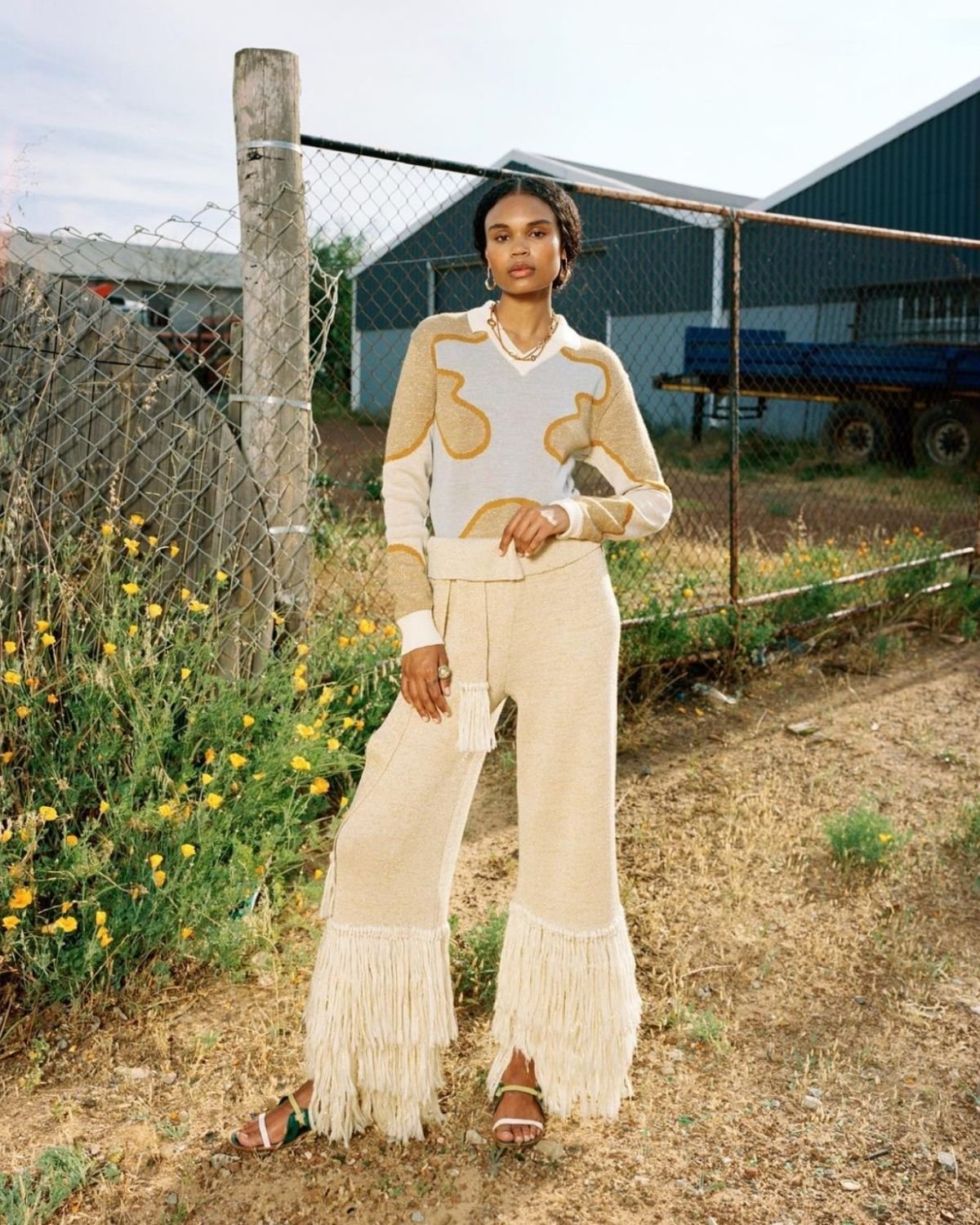Remain Ahead of the Curve by Checking Out Innovative Fashion Fads
In a sector as vibrant as style, remaining in advance includes more than just complying with present patterns-- it demands an exploration of advancement. Smart fabrics, for example, are changing garments into functional masterpieces, while 3D printing is revolutionizing design procedures with its personalized, waste-reducing capacities. As sustainability ends up being a foundation, technologies like eco-friendly products and round fashion practices are improving ecological obligation - Cape Town Sustainable Fashion. Additionally, the convergence of technology and style proclaims a new age of customer interaction. Exactly how, after that, can these arising fads redefine the future of style, and what ramifications do they hold for brand names seeking to flourish in this developing landscape?

Accepting Smart Textiles
In recent years, the apparel industry has actually witnessed a transformative shift with the assimilation of smart fabrics, a sophisticated development that blends technology with fabric. This advancement represents not only a combination of visual appeals and capability however also a considerable leap towards sustainability and customization in style. Smart textiles, likewise referred to as e-textiles, installed innovative electronics such as sensing units and conductive strings within the fabric, making it possible for garments to connect with the setting or the user.
These fabrics are made to check physical criteria, such as heart price or body temperature level, giving real-time wellness analytics. Past health applications, smart textiles are also being utilized for adaptive clothing, which can change color or pattern in response to environmental stimuli, therefore providing a dynamic style experience.
In addition, the growth of energy-harvesting textiles that generate power from activity or sunshine is leading the way for self-sufficient wearable innovation. This development is appealing to eco aware customers and designers intending to minimize the environmental footprint of fashion. As research and development in this field advancement, smart textiles are anticipated to come to be significantly widespread, improving the landscape of contemporary fashion with their multifunctional capabilities.
The Rise of 3D Printing
Transforming the manufacturing landscape, 3D printing has actually arised as a game-changer in the garment industry. This innovative modern technology has enabled designers to push the borders of creative thinking, producing detailed and customized garments that were formerly unthinkable. By leveraging digital layout and additive manufacturing, 3D printing helps with the production of complicated geometries and patterns, enabling designers to explore new appearances and structures.
A notable benefit of 3D printing in style is its capacity to create on-demand, reducing waste and reducing inventory demands. This effectiveness not only optimizes manufacturing procedures yet also allows for fast prototyping, allowing designers to bring their visions to life in a much shorter timeframe. Additionally, 3D printing supports modification somewhat unequaled by conventional approaches, using individualized fits and special styles customized to private consumer choices.
The increase of 3D printing has additionally equalized style, making it obtainable to emerging developers who can now make top notch items without significant financial investment in typical manufacturing framework. As technology remains to breakthrough, the fashion business is poised to harness the full capacity of 3D printing, exploring new products and strategies that will certainly redefine how style is developed and created.
Sustainable Fashion Innovations
As the apparel industry grapples with the pressing need for ecological duty, lasting fashion developments have actually emerged at the leading edge of transformative modification. The growing awareness of eco-friendly effect has sustained a change towards more eco-conscious techniques and materials. Brands and designers are currently prioritizing sustainability, incorporating approaches that lessen waste and decrease carbon footprints.
One significant growth is the surge of circular fashion, which emphasizes recycling and upcycling to expand the lifecycle of garments. This technique not only decreases waste but additionally urges consumers to take on an extra conscious method to clothes consumption.
Another breakthrough depends on the fostering of cutting-edge dyeing methods that make use of natural dyes or waterless procedures, thereby minimizing the vast amounts of water and chemicals commonly used in fabric dyeing. Additionally, improvements in biotechnology have caused the production of lab-grown leather and materials, offering cruelty-free and eco-friendly options to conventional products. Through these pioneering efforts, the fashion market is making purposeful strides in the direction of an extra lasting future.

Tech-Integrated Garments
Tech-integrated clothing represents a cutting-edge blend of fashion and technology, improving exactly how individuals communicate with their clothes. This cutting-edge domain name is noted by the incorporation of wise fabrics and embedded digital elements, this page boosting both functionality and visual allure. From fitness trackers embedded in sports apparel to warmed jackets regulated by means of smart device apps, tech-integrated apparel provides consumers extraordinary ease and versatility.
Pioneering brands are driving this pattern, focusing on developing garments that reply to ecological stimulations or user commands. For instance, some garments can alter shade or pattern in action to temperature level changes, while others include biometric sensors to keep an eye on wellness metrics like heart rate or anxiety levels. The seamless assimilation of innovation into fabrics additionally encompasses environmental sustainability, with efforts to establish self-cleaning fabrics or garments that adapt to weather problems, therefore lessening the demand for several layers.
In addition, the introduction of wearable innovation is not just limited to apparel however encompasses devices like watches and eyeglasses, additional broadening the scope of tech-integrated style. As the industry proceeds to introduce, the capacity for personalization and customization in clothing grows, supplying customers unique, tech-enhanced style experiences that deal with their private needs and choices.
Future of Virtual Fashion
In recent years, the future of virtual fashion has become a transformative force within the sector, leveraging innovations in digital innovation to redefine just how style is created, experienced, and eaten. By incorporating enhanced reality (AR), online truth (VIRTUAL REALITY), and 3D design devices, designers explanation can currently craft interactive and immersive experiences that transcend traditional style limits. Online style enables the development of garments that exist exclusively in electronic atmospheres, supplying unlimited opportunities for technology without the constraints of physical manufacturing.
This digital change not only provides opportunities for imaginative expression yet likewise addresses sustainability problems integral in traditional fashion practices. Cape Town Sustainable Fashion. By getting rid of the demand for physical sources, virtual fashion lowers waste and reduces carbon impacts. Furthermore, the surge of online style lines up with the increasing consumer need for individualized and one-of-a-kind experiences, as virtual garments can be customized and tailored to individual preferences easily

Final Thought
The fashion industry's future lies in the integration of ingenious modern technologies and sustainable methods. Digital fashion is poised to redefine customer communications.
In recent years, the style industry has actually witnessed a transformative shift with the assimilation of wise fabrics, a sophisticated advancement that blends innovation with material.As the fashion sector grapples with the pushing need for ecological obligation, lasting fashion technologies have arised at the leading edge of transformative adjustment.In recent years, the future of digital fashion has actually arised as a transformative force within the market, leveraging developments in electronic technology to redefine just how fashion is created, experienced, and consumed. The rise of digital fashion straightens with the boosting customer demand for one-of-a-kind and Full Report customized experiences, as virtual garments can be tailored and tailored to private choices with ease.
The style sector's future lies in the assimilation of ingenious technologies and lasting methods.